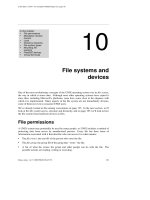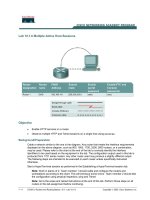C++ Lab 10 Structures (Struct) and Files pot
Bạn đang xem bản rút gọn của tài liệu. Xem và tải ngay bản đầy đủ của tài liệu tại đây (143.62 KB, 6 trang )
Lab 10
Structures (Struct) and Files
Dr. Abraham
Up until now you have been declaring variables of simple (atomic) data types.
Suppose you want to keep inventory of things you sell. Each item you have in stock has
a name (string), a price (double), and a quantity (integer). It would be nice to keep them
together and give it one name. That is what “Struct” does for us. In other languages it
may be called a “Record”. We can use a class as well which is covered in the next
chapter. With object oriented programming it does not make sense to use struct any
more. Nevertheless we C++ needs to be backward compatible to some extent. So let us
dive directly into struct. To set up variables of a struct data type, one must declare a data
type and then declare variables of that data type. Here is an example of declaring a struct
data type. Each component of the struct is called a data members or fields. In the
following example we will declare a struct data type called InvItem.
struct InvItem
{
int partNum;
string description;
int onHand;
float price;
};
InvItem in this example is used like a type. It can’t be used to place
values in it. A variable must be declared before using it. Here is
how to declare the variable “part” and initialize it.
InvItem part = {1111, “Fountain Pen”, 10, 20.25}
Once the struct data type is declared, variables of this type can be made just as any other
variable declaration. You can create any number of variables out of this struct, as in the
following program 10-1. Values can be placed in the member fields either by initializing
as shown above or by assigning values using the assignment operator (=) or by reading
like this:
part.partNum = 1111;
cin >> part.partNum;
Program 10-1
/* This program has a function that uses structure.
Created for my CSCI 1370 students
Dr. John P. Abraham */
#include <iostream>
#include <string>
using namespace std;
struct InvItem
{
int partNum;
string description;
int onHand; //inventory on hand
float price;
};
//2 prototypes
void getItem(InvItem&);
void showItem(InvItem);
int main()
{
InvItem part, copyPart;
getItem(part);
copyPart = part;
showItem(copyPart);
cin.ignore();getchar();
return 0;
}
void getItem(InvItem& piece)
{
cout<<"Enter the part number: "; cin>>piece.partNum;
cout<<"Enter the description: "; cin.get();
getline(cin,piece.description);
cout<<"Enter the quantity on hand: "; cin>>piece.onHand;
cout<<"Enter the unit price: "; cin>>piece.price;
}
void showItem (InvItem piece)
{
cout<<"\n==================================\n";
cout<<"Part Number: "<<piece.partNum<<endl;
cout<<"Description: "<<piece.description<<endl;
cout<<"Inv on hand: "<<piece.onHand<<endl;
cout.precision(2);
cout.setf(ios::fixed|ios::showpoint);
cout<<"Price: $"<<piece.price<<endl;
}
Program Run 10-1
Files
We have already visited files in earlier chapters where we created files to create
print files. After opening a file, a stream of characters were sent to the file through a
buffer. Finally when a file is closed an end of file marker (^Z) is placed to indicate that
the stream has ended. A file stream can be either input stream or output stream. In C++
and many other languages, peripheral devices are considered as files as well. Standard
input (keyboard file) and output (monitor file) are automatically opened. All we had to
use was the cin >> or cout <<. These streams are made available to us through the
iostream. In order for us to create other streams we need to include fstream. This
include file will allow us to use two classes: ofstream for output file stream and ifstream
for input file stream. Using these classes we can create variables and throughout the
program we refer to these variables we created. Each variable we create inherits member
functions that can be invoked using the dot notation, example: outfile.open (“myfile.txt”)
or outfile.close().
Stream: Channel or circuit on which data are passed from sender to receiver one
character at a time. If receiving data, it is called input stream. If sending data it is
called output stream.
Streams are connected to Devices. Example, cin is connected to keyboard and cout is
connected to monitor.
file streams are stored on disk device.
Here some ios member functions:
ios::in Open in input mode
ios::out Open in output mode
ios::app Open in append mode
ios::ate Go to the end of opened file
ios::binary Open in binary mode
ios::trunc Delete file contents if it exists
ios::nocreate if file does not exist, open fails
ios::noreplace if file exists, open for output fails.
C++ provides for error checking while dealing with files. For examples, what
happens if a user does not put a disk in drive A? A robust program should check for
errors and recover from it. C++ provides an include file, assert.h, to help us catch errors.
In the following examples I will be using some functions provided by assert.h.
Program 10-2 (Writing to a file)
#include <iostream>
#include <fstream>
#include <assert.h>
using namespace std;
int main()
{
fstream outfile ;
outfile.open ("a:test",ios::app);
assert(! outfile.fail());
outfile << 25 <<" " << 38 << " " << 95 <<endl;
outfile.close();
return 0;
}
Program Run 10-2
Assertion failed: ! outfile.fail(), file c:\c-2005\files1\files1\files1.cpp, lin
e 11
Important:
Re-run the program with
outfile.open ("c:\test",ios::app);
Program 10-3 (Read from a file)
#include <iostream>
#include <fstream>
#include <assert.h>
using namespace std;
int main()
{
int a;
fstream infile ;
infile.open ("c:\test",ios::in);
assert(! infile.fail());
/* Here are two other loops you could use
for (;;)
{
infile >> a;
if (infile.eof()) break;
cout << a << endl;
}
do
{
infile >>a;
if (!infile.eof()) cout <<a<<endl;
}
while (infile.peek() !=EOF);
*/
while ((infile.peek()) !=EOF)
{
infile >>a;
if (!infile.eof()) cout <<a<<endl;
}
infile.close(); //close file.
cin.ignore();getchar();
return 0;
}
Here is a program to make a copy of a text file.
Program 10-4
/**************************************************
Program by Dr. John P. Abraham
Program copies a text file.
for Students of 1370
************************************************/
#include <iostream>
#include <fstream>
using namespace std;
int main()
{ char infilename[30], outfilename[30];
cout << "Enter file name to copy from: "; cin>>infilename;
cout << "Enter file name to copy to: "; cin>>outfilename;
ifstream infile; ofstream outfile;
infile.open(infilename);
outfile.open(outfilename);
char inc;
infile.get(inc);
while(!infile.eof())
{
infile.get(inc);
cout <<inc;
outfile << inc;
}
infile.close();
outfile.close();
return 0;
}
Assignments (the fist one is easy, the second one is challenging):
1. Re-write the file copy program (10-4) with two functions one to open the infile
and another one to open the outfile. One other modification to the program would
be instead of reading and writing one character at a time, read one line and write
one line at a time (use getline). It is important to know to pass files (streams) as
reference parameters.
2. Write a program to write struct in program 1 into a text file. Write another
program to read that data into struct.









